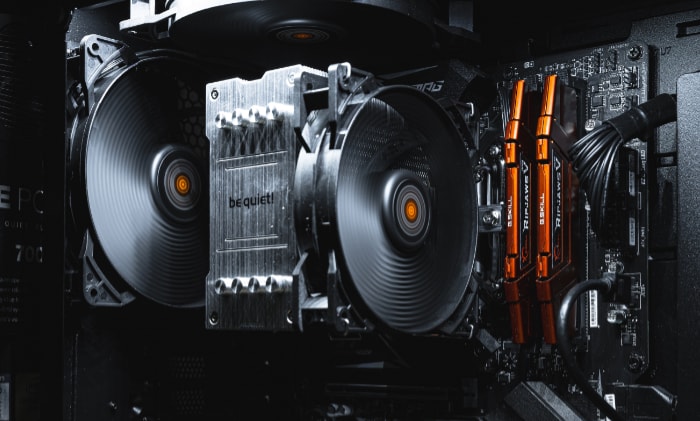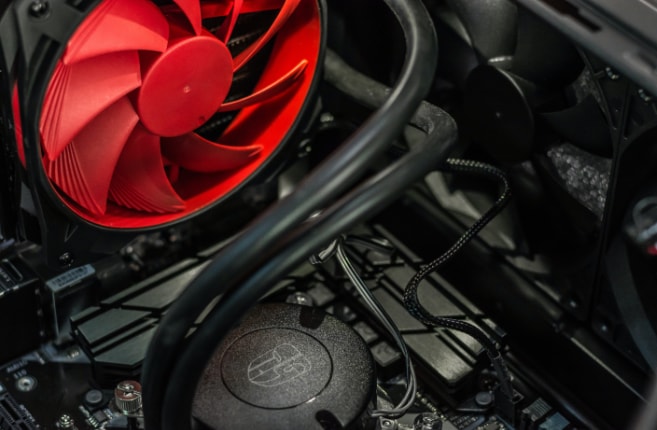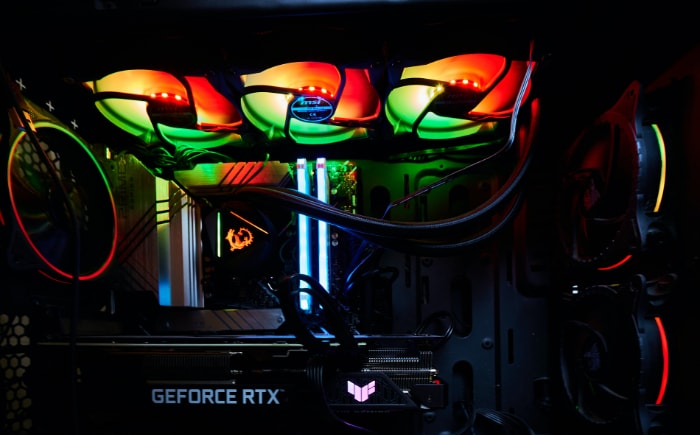AIO Cooling vs. Air Cooling: Which is Right for Your PC?

Temperature control is a critical aspect of maintaining the performance and longevity of your computer system. Whether you're a hardcore gamer, a creative professional, or a tech enthusiast, ensuring efficient heat dissipation from your system is crucial.
The two most common cooling solutions employed today are air cooling and All-In-One (AIO) cooling. While air coolers use the natural mechanism of convection to reduce system temperatures, AIO coolers utilize the superior thermal conductivity of liquids.
In this comprehensive guide, we will explore the details of these two systems, comparing their benefits and drawbacks, and helping you decide which cooling solution is right for your PC. Buckle up for an enlightening journey into the world of PC cooling.
Understanding PC Cooling Systems
As we dive deeper into the realm of PC cooling solutions, it's essential to first understand what a cooling system does in a PC and familiarize ourselves with the thermal design power (TDP) concept, a critical factor in cooling system selection.
The Role of Cooling Systems in a PC
A PC's cooling system is tasked with managing and dissipating the heat produced by its components, particularly the central processing unit (CPU) and graphics processing unit (GPU), which are primary heat sources due to their high performance. Other components like the power supply unit (PSU), memory modules, and even storage drives can also contribute to the overall heat inside a PC case.
During the operation of these components, electrical energy is converted into thermal energy, which, if not adequately managed, can cause the components to overheat. Overheating can lead to throttling (a self-preserving reduction in performance), or in severe cases, permanent damage to the components.
By effectively removing this heat, a cooling system ensures your PC maintains optimal performance and reliability.
Different Types of Cooling Systems
Broadly, cooling systems can be divided into two types: passive cooling and active cooling. Passive cooling uses heat sinks and the natural process of convection to disperse heat, whereas active cooling involves fans or pumps to actively distribute cool air or coolant to hot components.
Two of the most popular active cooling methods used in modern PCs are air cooling, which uses fans and heat sinks, and liquid cooling, which uses a liquid coolant to absorb and move heat away from components. All-In-One (AIO) cooling is a form of liquid cooling where the components – a pump, radiator, and fans – are combined into a single, often user-friendly package.
Understanding Thermal Design Power (TDP)
TDP is a term used by manufacturers to specify the amount of heat a system or component (like a CPU or GPU) is expected to generate under maximum load. Measured in watts, it is a critical specification when selecting a cooling solution.
Your chosen cooler must be rated for at least the TDP of the component it's cooling. For instance, if a CPU has a TDP of 95 watts, the cooling solution should be able to effectively dissipate at least 95 watts of heat.
What is Air Cooling?
Air cooling, as the name suggests, uses air as a medium to dissipate the heat generated by the PC's components. This is achieved through the use of fans and heat sinks, which work together to cool the PC's internals efficiently.
The Mechanics of Air Cooling
At the core of an air cooling system are two critical components: the heat sink and the fan.
The heat sink is a metallic object, often made of aluminum or copper, with multiple fins or ridges. It's designed to have a large surface area for efficient heat dissipation.
The heat sink is placed directly onto the heat-generating component (like the CPU or GPU), and it absorbs the heat produced by that component.
The fan, on the other hand, is responsible for moving cool air across the heat sink. As the cool air moves across the fins of the heat sink, it carries away the heat, thereby cooling the component.
Advantages of Air Cooling
Air cooling systems have several advantages:
Cost: Air coolers are generally less expensive than their AIO counterparts. They offer a cost-effective solution for users who have a tighter budget or don't plan on pushing their systems to extreme limits.
Reliability: With fewer moving parts than AIO coolers, air coolers have less potential for mechanical failure. There are no liquids involved, so there's no risk of leakage damaging other components.
Ease of Installation: Most air coolers are easy to install, making them a great option for those building their first PC or those who prefer a simpler setup.
Disadvantages of Air Cooling
However, air cooling isn't without its drawbacks:
Efficiency at Higher TDP: While air coolers are sufficient for most users, they may struggle to keep up with components with a very high TDP, especially during prolonged periods of maximum load. This can lead to higher temperatures, potentially causing thermal throttling or component damage.
Noise Levels: Air coolers can be louder than AIO coolers, especially at higher fan speeds. This could be a concern for users who prioritize a quiet working or gaming environment.
Physical Size and Clearance Issues: High-performance air coolers can be quite large, and there might be clearance issues with some PC cases or RAM modules. Always check the dimensions of the cooler and your case before purchase.
What is AIO (All-In-One) Cooling?

AIO cooling, also known as closed-loop cooling, is a form of liquid cooling where all the components necessary for the cooling process – a pump, radiator, tubes, and fans – are packaged into one system.
Unlike custom loop cooling that requires individual component selection and assembly, AIO cooling systems are ready to install out of the box, making them a user-friendly option for those wanting the benefits of liquid cooling without the complexity of a custom setup.
How AIO Cooling Works
AIO cooling operates on the principle of convection and phase transition to cool PC components. Here's a simple step-by-step process:
- The pump, mounted on the CPU or GPU, circulates a liquid coolant through a closed loop.
- As the coolant passes over the heat-generating component, it absorbs the heat, raising its temperature.
- The heated coolant then travels to the radiator, where it is cooled by fans. The heat dissipates into the surrounding air, and the coolant temperature drops.
- The cooled liquid then flows back towards the heat-generating components, and the cycle repeats.
The AIO cooling loop ensures a constant flow of coolant, continuously transferring heat away from the critical components to maintain optimal operating temperatures.
Advantages of AIO Cooling
AIO cooling systems offer several benefits:
Aesthetic Appeal: With their sleek designs and often customizable RGB lighting, AIO coolers can significantly enhance the aesthetic appeal of your PC.
Potential for Higher Performance: AIO coolers can offer superior cooling performance, especially for components with a high TDP. They are typically more efficient than air coolers in maintaining lower temperatures under heavy load.
Space-saving Design: Unlike bulky air coolers, AIO coolers are more compact, freeing up space inside the PC case. The main bulk of the cooler – the radiator – is typically mounted to the side of the case, leaving more room around the motherboard.
Disadvantages of AIO Cooling
However, there are also a few potential drawbacks of AIO cooling:
Price: AIO coolers generally cost more than air coolers, which could be a deterrent for those on a tighter budget.
Maintenance and Potential for Leaks: While AIO systems are mostly maintenance-free, they still have the risk of leaks over time, which could potentially damage other components.
Lifespan and Pump Failure: The pump in an AIO cooler is a moving part that can fail over time. When the pump fails, the entire cooler must be replaced, as the pump is not typically user-replaceable in AIO systems.
Comparing AIO Cooling and Air Cooling
Now that we have an understanding of both air cooling and AIO cooling, it's time to put these two side by side. In this section, we'll compare their performance, cost, noise levels, reliability, lifespan, and aesthetics.
Performance Comparison
Air Cooling: Air cooling is efficient and sufficient for most general use cases and lower-end gaming setups. However, for components with higher TDPs or in overclocking scenarios, air cooling may struggle to maintain optimal temperatures.
AIO Cooling: Due to the superior heat conductivity of liquid compared to air, AIO cooling often offers better cooling performance. This makes it an ideal choice for high-end, high-performance setups, and in scenarios where overclocking is preferred.
Cost Comparison
Air Cooling: Generally, air coolers are less expensive, making them a more cost-effective choice for budget-conscious users or for those who don't plan to push their systems to the extremes.
AIO Cooling: On the other hand, AIO coolers tend to be pricier, reflecting their advanced technology and superior performance. They may be a worthwhile investment for those seeking high-end performance and aesthetics.
Noise Comparison
Air Cooling: Air coolers can get quite loud, especially under heavy loads where the fans need to spin at high speeds. However, the noise level varies greatly among different models and brands.
AIO Cooling: While AIO coolers still use fans, they often run quieter than air coolers. High-end AIO coolers may also come with better quality fans that produce less noise.
Reliability and Lifespan Comparison
Air Cooling: With fewer moving parts and no liquid to potentially leak, air coolers can be very reliable and long-lasting.
AIO Cooling: Despite being mostly maintenance-free, AIO coolers come with the risk of pump failure over time. However, this risk is generally low, and many AIO coolers are designed to last for several years.
Aesthetics and Size Comparison
Air Cooling: Air coolers can be quite bulky, taking up a lot of space in the PC case. While some people appreciate the robust, industrial look of a large air cooler, it might not be to everyone's taste.
AIO Cooling: In contrast, AIO coolers offer a cleaner, more streamlined look. They also allow more internal visibility in the case, which is often appreciated by users with windowed PC cases. Plus, they often come with RGB lighting for an added aesthetic appeal.
Tips on Choosing Between AIO and Air Cooling

When choosing between an AIO and an air cooler, several factors can guide your decision. Your unique needs, the hardware you're cooling, your budget, noise considerations, and aesthetic preferences can all influence your choice.
Here are some tips to help you choose the most suitable cooling system for your PC.
Assess Your Cooling Needs
First and foremost, evaluate your cooling needs. Are you running a general-purpose PC, a gaming setup, or a workstation for intensive tasks like 3D rendering or video editing?
High-performance setups generate more heat and therefore require a more efficient cooling system like an AIO cooler. For regular usage or mid-tier gaming, an air cooler may be sufficient.
Consider Your Budget
Air coolers generally provide a more cost-effective solution, suitable for budget builds. If cost is a significant factor, an air cooler may be the best choice.
However, if your budget allows, investing in an AIO cooler can provide enhanced cooling performance and aesthetic appeal.
Understand the TDP of Your Components
Check the Thermal Design Power (TDP) of your CPU or GPU. If the TDP is high, you might need a cooler that can dissipate heat more effectively, leaning towards an AIO solution.
For components with lower TDP, an air cooler should be sufficient.
Noise Considerations
If you're sensitive to noise, you might want to choose an AIO cooler as they tend to operate quieter than air coolers. However, there are also air coolers designed for quiet operation, so don't rule them out completely.
Aesthetic Preferences
If you prioritize aesthetics and have a case with a window to display your components, an AIO cooler's sleek design might appeal to you. On the other hand, if you appreciate the rugged, industrial look of a large heatsink and fan, an air cooler could be the way to go.
Space and Clearance in Your PC Case
Finally, consider the physical size and clearance in your PC case. If space is tight, the compact design of an AIO cooler might be beneficial.
Conversely, if you have a spacious case and plenty of clearance, a high-performance air cooler could fit perfectly.
Conclusion
Understanding the science behind PC cooling is an integral part of owning or building a computer. It directly influences the system's performance, longevity, and operational noise levels.
From cost-effective air coolers to efficient and visually pleasing AIO systems, there are a variety of options available to suit different use cases and preferences.
Through this exploration of air cooling and AIO cooling, we have unveiled the mechanics, advantages, and disadvantages of each system. We've also provided a detailed comparison and tips on choosing the most suitable solution for your specific needs.
In the end, whether you opt for an air cooler or an AIO cooling solution depends on your PC's specific needs, your personal preferences, and your budget. Both solutions are designed to effectively manage heat and have their own unique strengths.
Remember, optimal cooling contributes significantly to a PC's health, reliability, and performance. So take your time to make an informed decision, and you will ensure your PC's vital components stay cool, even under heavy loads.
After all, maintaining the right temperature is crucial to keeping your PC performing at its best for years to come.


